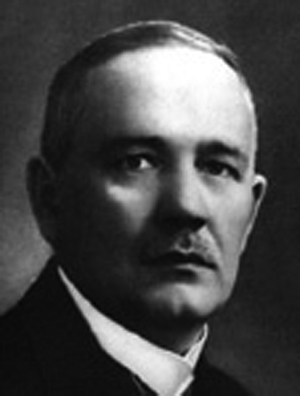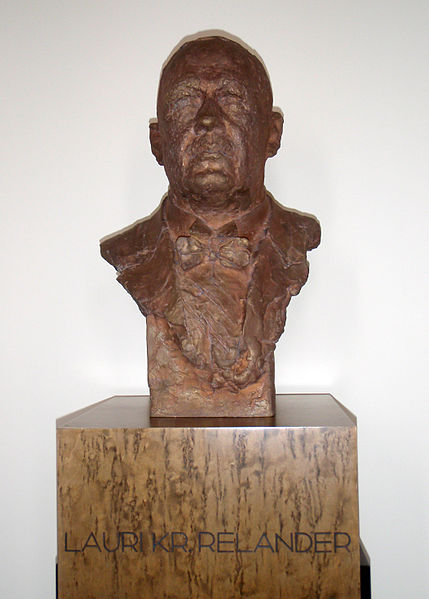<Back to Index>
- 2nd President of Finland Lauri Kristian Relander, 1883
PAGE SPONSOR


Lauri Kristian Relander (May 31, 1883 – February 9, 1942) was the second President of Finland (1925 – 1931). A prominent member of the Agrarian League, he served as a member of Parliament, and as Speaker, before his election as President.
Relander was born in Kurkijoki, in Karelia, the son of Evald Kristian Relander, an agronomist, and Gertrud Maria Olsoni. He was christened Lars Kristian, but he Finnicized his first name to Lauri during his time at school. Relander followed in his father's footsteps by enrolling at the University of Helsinki in 1901 to study agronomy. He gained his first Bachelor's Degree in Philosophy in 1905, and his second – in Agronomy – the following year. That year also saw his marriage to Signe Maria Österman (1886 – 1962). They had two children, Maja - Lisa (1907 – 1990) and Ragnar (1910 – 1970).
The major subjects for Relander's Master's Degree,
which he gained in 1907, were agricultural chemistry and agricultural
economics. After obtaining his degree, Relander worked from 1908 to 1917
as a researcher at a state agricultural experimental institution,
carrying out some important research in his field. He also continued his
studies, gaining his Doctorate in
1914. However, his attempts at this time to gain a lectureship at the
University of Helsinki failed. At this time Relander was also
politically active in the Agrarian League.
He was elected to Parliament in 1910, serving until 1913, and again
from 1917 to 1920. By 1917 he had become one of the leaders of the
party.
After independence, his political career went well. He was a prominent member of his party, and served on a number of parliamentary committees. Relander was elected as Speaker of the Eduskunta for its 1919 session and part of its 1920 session. Later that year he was appointed Governor of the Province of Viipuri. However, in the 1920s he did not have enough support in his own party to become a minister.
In
1925, Relander was nominated as his party's candidate for that year's
presidential election – his nomination only being confirmed just days
before election day. Relander was only 41 at the time, and his
nomination came as a surprise. It was further guaranteed by the fact
that some of the party's key figures, such as Santeri Alkio and Kyösti Kallio, declined to stand. Relander was elected in the third ballot of the electoral college, defeating the National Progressive Party candidate Risto Ryti by
172 votes to 109. He was elected largely due to the fact that he
attracted less opposition than Risto Ryti.
According to some contemporaries, at least the Swedish People's Party
electors more eagerly voted for Relander, because his wife happened to
be a Finland Swede. This story may be partly apocryphal, because also
Ryti had a Finland Swedish wife. On the other hand, Ryti had campaigned
as a "Finnish peasant's son." Strong right wing opposition to the
outgoing Progressive (liberal) President Ståhlberg, Ryti's
membership in the same party, and at least some career politicians'
desire for a more approachable and less independent President may partly
explain Relander's victory. Two other important factors should be
mentioned: Relander was an active member of the "Suojeluskunta" (Civil
Guard) voluntary military organization and he accepted the right wing
worldview typical of White veterans of the Civil War clearly more
wholeheartedly than Ryti did. Also as people, Relander and Ryti were
notably different: despite having a doctorate, Relander was a much more
talkative and social person than the intellectual and thoughtful Ryti.
As President, Relander was politically inexperienced and young. Politicians and other opinion leaders could not take him seriously. Relander had no political base to speak of, and he was deemed to have no particular program for his presidency, which further decreased his support. Even Relander's continual state visits and trips drew criticism, leading to him gaining the nickname of Reissu - Lasse ('Travelling Larry'). He was continually compared to Kaarlo Juho Ståhlberg and his performance as president. The cabinets during his term tended to be weak, short lived minority cabinets, like in most European democracies of that time. All in all, Relander is remembered as a weak leader. On the other hand, Relander was an idealist who deplored the toughness of the political game and preferred minority governments of supposedly excellent individuals over majority governments of unprincipled individuals. While Relander cannot be considered a strong President, he did a few notable things during his single term: he allowed the Social Democrats to form a minority government (1926 – 27), appointed Finland's first female Cabinet minister, Miina Sillanpää (as Assistant Minister of Social Welfare), dissolved Parliament twice (in 1929 over a dispute on the civil servants' salaries, and in 1930 to have the Parliament outlaw the Communist Party, which required a constitutional amendment and thus a two - thirds majority), and generally speaking supported the far - right Lapua Movement, until it started to kidnap various political opponents. He maintained a rather close friendship with the Social Democratic leader, Väinö Tanner.
In the late autumn of 1930, Relander realized he would not be re-elected, and during the winter of 1930 – 31 he sabotaged the prospects of his former Agrarian League colleague and rival Kyösti Kallio, so that Pehr Evind Svinhufvud, Relander's former Prime Minister, was elected. In Relander's opinion, Kallio did not talk straight to him and schemed behind his back to weaken his Presidency and help his political opponents. In Kallio's opinion, Relander was a rather inexperienced politician who had high ideals but not enough common sense to implement them. After his term as President, he served from 1931 to 1942 as the General Manager of Suomen maalaisten paloapuyhdistys, a fire insurance company for rural people. Relander died in 1942 of heart failure.